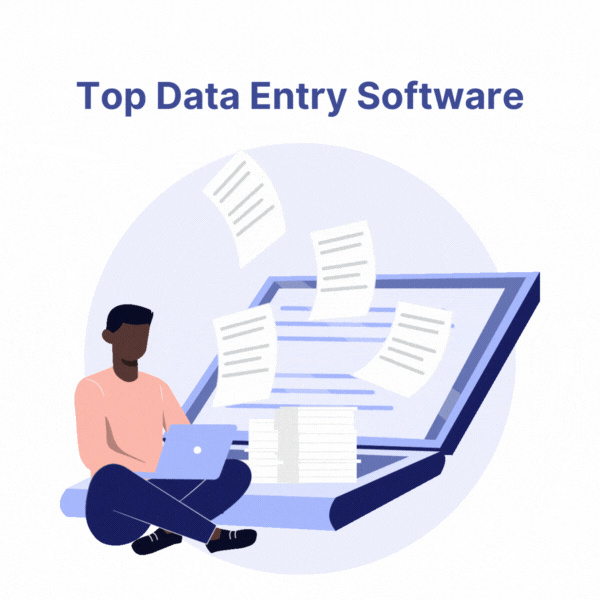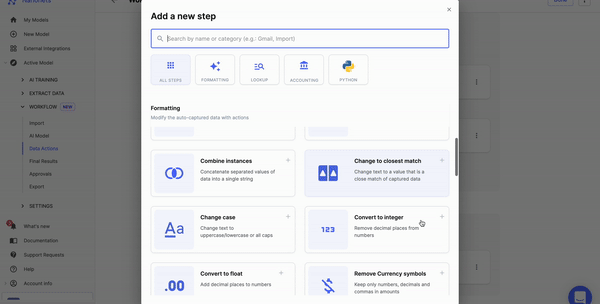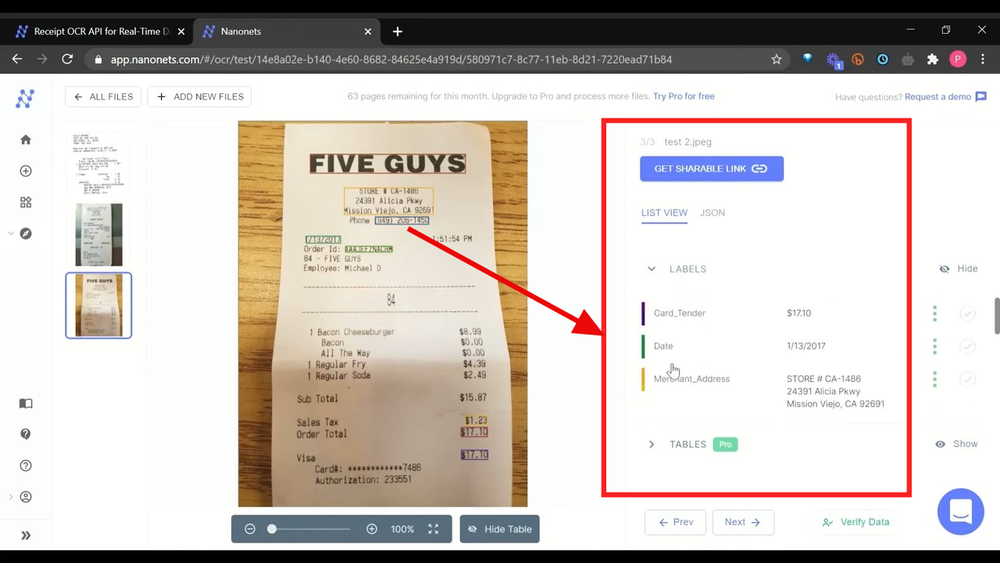
Data entry is tedious, repetitive, and mind-numbing. But it's crucial for businesses. Inputting data from paper records, scanned documents, or between different business systems ensures accurate records. However, manual data entry wastes valuable time and resources. Professionals lose at least a quarter of their workweek on this task.
Thankfully, modern data entry software automates the process. It captures and transforms data intelligently and syncs it across applications — no more discrepancies or errors. Intelligent automation redefines precise data management. These tools save time, boost productivity, and reduce costs.



So, how do you choose the right data entry solution for your team? This article compares the top data entry software options available and helps you identify the best one for your company.

What is data entry software?
Data entry software is a transformative tool that streamlines the capture and export of information into your database, accounting software, or CRM systems. For example, it enables you to capture and extract data from invoices to QuickBooks, saving time and reducing errors.
This technology speeds up data handling and enhances accuracy, ensuring that insights derived from your data are reliable and actionable. By adopting data entry software, you can turn your focus to strategic analysis and decision-making, leaving the repetitive data shuffling to automated, intelligent processes.
Explore how these tools can revolutionize your workflows and unlock productivity on levels previously unattainable with traditional methods here.

The 9 best data entry software for advanced automation in 2024
1. Nanonets
Nanonets Data Entry Software
Nanonets is an AI document automation software that can automate manual data entry processes with no-code workflow automation.
Nanonets can extract data from PDFs, documents, and handwritten documents using its in-built OCR software with 95% accuracy. It also integrates with 5,000+ applications via API and Zapier.
This makes Nanonets a perfect choice for AI-powered data entry software. With the best OCR software and advanced workflow, Nanonets can seamlessly capture data from incoming sources and export transformed data flawlessly with in-app integrations.
Nanonets is the best choice for businesses and BPOs looking to automate manual document processes with secure document storage and advanced workflow management capabilities.
Rating: 4.9 on Capterra
Best For: Manual Data Entry Automation from documents to ERP, Accounting software & Databases
Top features:
- Automatically structure and extract data from forms, PDFs, scanned documents, and handwritten documents with a few clicks.
- Capture unstructured data from any document with 95% accuracy.
- Automate data entry processes with workflows. You can also automate approval processes, invoicing, and expense management.
- Perfect for data enrichment or data enhancement.
- Migrate data or integrate data from 5000+ applications with easy API connections and Zapier.
Pros of using Nanonets
- Intuitive user interface
- Can understand 200+ languages
- Forever Free Plan
- Transparent pricing - Check Pricing Plans
- Automated workflows that allow for automatic data processing
- Customizable as per your requirements
- 24x7 support
- 5000+ integrations to import data easily
- Great OCR API for the dev team

#2. Docparser
Docparser is a comprehensive document management solution for small industries and enterprises. Document parsing is conducted using a clear built-in text recognition or OCR engine. The pre-processing capacities comprise image processing, cropping, resizing, and auto-rotation.
Features:
- Supports QR scanning, barcode recognition, and OCR.
- Cloud-enabled sharing through Google Drive or Dropbox.
- Custom Parsing capacities.
- Multi-lingual support.
Pros of using Docparser:
- Intuitive Platform
- Good for template-based data extraction
Cons of using Docparser:
- No phone support
- Costs increase exponentially for large batches
- Not great for new types of documents
- Quality is highly dependent on the quality of images. Fuzzy matching could be better.
- Handwriting text recognition isn't accurate
#3. FoxTrot RPA

Foxtrot RPA is another data entry software that can automate data entry processes using RPA workflow automation. Foxtrot RPA adds intelligent automation to automate manual tasks by observing keystrokes or mouse movements.
Additionally, the data entry system can simplify data capture, data wrangling, and export for non-technical users. Also, with Foxtrot RPA, you can effortlessly receive your Excel tables and data without encountering any missing fields.
Features:
- Image capture
- Fit and merge your data
- Delivers a complete catalog of mathematical formulas
- Stimulates data management capabilities like discovery, data cleaning, and retrieval
Pros of using FoxTrot RPA:
- Automate PC data entry processes with a screen recording feature.
- It allows you to custom code, SQL, and PowerShell, which expands its functionality.
Cons of using FoxTrot RPA:
- Lacks integrations into Adobe, SharePoint, and other products
- Getting data into the system is difficult
- Needs improvement in execution and control
- Doesn't work properly with browsers
#4. Docsumo

Docsumo is a document processing solution that facilitates operation teams to extract data accurately.
Features:
- Intelligent data capture and transport
- Data Quality Control and Replication
- Email and IP Address Extraction
- Abbreviation Detection
- Data Aggregation
Pros of using Docsumo:
- Simplistic UI.
- Customizable OCR API.
Cons of using Docsumo:
- The API documentation must comprise more details.
- UI should be more intuitive.
- A complex reporting system would make it better.
- Docsumo doesn't process handwritten papers.
#5. Nintex RPA

Nintex RPA is a cloud-based data entry system to automate manual procedures as well as data assignments.
Features:
- Data Capture and Transfer
- Archiving & Retention
- Data Quality Control
- Data Matching Control
Pros of using Nintex RPA:
- Foxtrot provides extreme flexibility in actions against disparate networks.
- Simple interface which does not need substantial prior knowledge to operate.
- Friendly and intelligent customer service agents.
Cons of using Nintex RPA:
- License expenses can be costly if you build multiple forms and workflows.
- Lacks major data integrations
- The software requires rigorous testing for its templates.
#6. Docupilot
Docupilot is a document automation software. Docupilot allows you to create documents from intelligent templates and sends the documents as email or to your favorite apps like Dropbox, DocuSign, and Zapier.
Pros of using Docupilot
- Best for document generation
- Integrates with Microsoft Office
- Easy to Use
Cons of using Docupilot
- Outdated UI
- Not apt to edit the document on the outlet; instead, editing in Word on the desktop and then uploading
- Adds a little time to the overall distraction.
- Better if more integrations are available
- Costly
- The UI of the product is not up to the mark
#7. Klippa

Klippa delivers automated document management, classification, processing, and data extraction solutions to digitize paper documents in your organization. Klippa can automatically extract data, classify, convert and verify documents with document workflows.
Features:
- Activity Dashboard
- Document Workflow Automation
- Accounting integrations
Pros of using Klippa:
- Great OCR API
- Extremely fast to setup an MVP
- Assistance can develop specific document templates
Cons of using Klippa:
- Customization options are limited.
- Can't configure OCR models by themselves.
- OCR recognition is not up to the mark
- Making bulk adjustments is tricky
#8. Google Document AI

Google Document AI utilizes machine learning and natural language processing to automatically process documents. Document AI uses deep-learning neural system algorithms to recognize character, text, and image recognition in about two hundred languages with incredible accuracy.
Features:
- Deep Learning Neural Network integration
- Cloud-vision OCR
- Greater precision for unstructured data extraction
Pros of using Google Document AI:
- A simplistic user interface assures seamless navigation.
- Decent decision-making with document data.
- Automate data to improve the efficiency of workflows.
Cons of using Google Document AI:
- Customization of prevailing libraries and modules is boring and takes time and experience.
- Lacks advanced features
- Absence of assistance for Python and many other coding languages.
- The API expenses add up rapidly during the setup procedure.
#9. Grooper

Grooper is a document automation and processing platform that helps industries in the expertise of finance, healthcare, legal and other areas. Grooper processes and extracts data from several sources, such as MS Word documents, PDFs, emails, and additional digital sources.
Features:
- Data archiving
- Data supply chain management
- Image processing
- Data profiling
- Data discovery and extraction
- Natural language processing
- Data quality control
Pros of using Grooper:
- Feature-packed software
- Very little downtime
- Image recognition is great.
Cons of using Grooper:
- Outdated UI
- Difficult to navigate
- OCR results are inaccurate frequently.
- Not for small businesses
- Need to know programming to use the software
The best data entry software
We’ve looked at all the best data entry platforms in the market today. There are many notable mentions like Jotform, Zoho, and Veryfi. We’ve compared the features of the top 10 data entry software companies in the snapshot below:
Our best picks for data entry software are:
- Nanonets
- DocParser
- Klippa
Must-have features of data entry software
To streamline your workflows, ensure your data entry software has these critical features:
| Feature | Description |
|---|---|
| Data Classification | Organizes and structures incoming data into a suitable format for future use and analysis. |
| Data Extraction | Processes and categorizes unstructured data, transforming it into a usable format. |
| Data Cleaning | Scans through data sets to identify and correct errors, duplicates, or missing values, ensuring data accuracy and consistency. |
| Data Validation | Ensures the accuracy and integrity of data during entry by enforcing rules and constraints. |
| Document Scanning | Allows scanning and storing of visual data alongside text-based data, and can digitize physical data sets and spreadsheets. |
| Electronic Forms | Enables the creation of custom forms to capture essential data, with autofill features to streamline form completion and reduce errors. |
1. Data classification
Before a document enters your business systems, its content may need to be organized in a helpful and efficient manner. Data classification features serve this purpose by capturing the incoming data and structuring it into a format suitable for future use and analysis.
2. Data extraction
Often, you need to work with poorly structured or unstructured data sources and transform them into a usable format. Automated data extraction can help you process and categorize unstructured data, making it valuable for your industry.

3. Data cleaning
Sometimes, data can be messy, with errors, duplicates, or missing values. Data cleaning tools scan through a given data set (such as a record set, table, or database) and examine it for specific predefined errors, blank spots, and inconsistencies. It ensures the data is accurate and consistent before further processing or analysis. This step is crucial for maintaining data integrity and making reliable decisions based on the information.

4. Data validation
Data validation is the process of ensuring the accuracy and integrity of data during entry. It helps prevent common data entry errors, eliminating the need for extensive data cleaning later. Essentially, data validation tools within a system enforce rules and constraints to ensure that the data entered is valid and meaningful.

5. Document scanning
For industries that rely heavily on visual data, in addition to text-based data, specialized data entry systems allow you to scan and store images alongside your other data. Furthermore, advanced document scanning software can digitize physical data sets and spreadsheets, converting them into usable digital formats within your system.

6. Electronic forms
Most data entry software allows you to create custom forms to capture the essential data needed for input. Autofill features can streamline form completion and reduce redundancy while also enabling error-checking. The software then organizes the form data into structured, categorized layouts for efficient storage and analysis.

Conclusion
Dealing with data entry tasks manually takes a lot of time and effort. And even after all that effort, the final output might be riddled with errors. Intelligent automation platforms like Nanonets or data entry services simplify the data entry process by automatically capturing data from incoming sources and updating the transformed data into required applications in real-time.
If you have similar requirements, feel free to contact our automation experts. You can set up a free consultation call with our team, where the experts will demonstrate how Nanonets can automate manual processes at your organization at a fraction of the cost.
Read more about data processing on Nanonets:
- Top data extraction tools for data-driven organizations
- Automate data entry using these tools
- Top 10 Data Migration Tools that you must know
- How to automate data processing in your organization?
Data entry software FAQs
Which is best software for data entry?
Here is the list of the best data entry software in 2024:
- Nanonets
- Docparser
- Klippa
- Docsumo
- Nintex RPA
- Grooper
- FoxTrot RPA
- Docupilot
- Document AI
What applications are used for data entry?
You can use the following data entry applications to automate data entry in your organization:
- Nanonets
- Docparser
- Klippa
- Docsumo
- Nintex RPA
- Grooper
- FoxTrot RPA
- Docupilot
- Document AI
How to select the best data entry system?
Choose a data entry system that integrates seamlessly with your existing workflow, offers high accuracy, has a user-friendly interface, and provides robust data security. It should also support customization to fit your specific needs.
Which software is most used for data entry?
Microsoft Excel is among the most commonly used software for data entry due to its widespread availability and strong data manipulation and analysis features.
What is a data entry software?
Data entry software is a tool that facilitates the input, storage, and management of data in digital form, often streamlining the process through automation and error reduction.
How do we automate data entry?
To automate data entry, you can use AI-powered software like Nanonets. These tools can automatically extract data from documents, classify it, validate it, and export it to other systems. This eliminates manual data entry, reduces errors, and streamlines workflows. The process typically involves uploading documents, training the AI model, and setting up integrations
Is Microsoft Excel a data entry software?
While Microsoft Excel is commonly used for data entry, it is primarily a spreadsheet software. Dedicated data entry software, like Nanonets, leverages AI and machine learning to automate the entire data entry process - from data extraction and validation to integration with other systems - which Excel cannot do alone.



